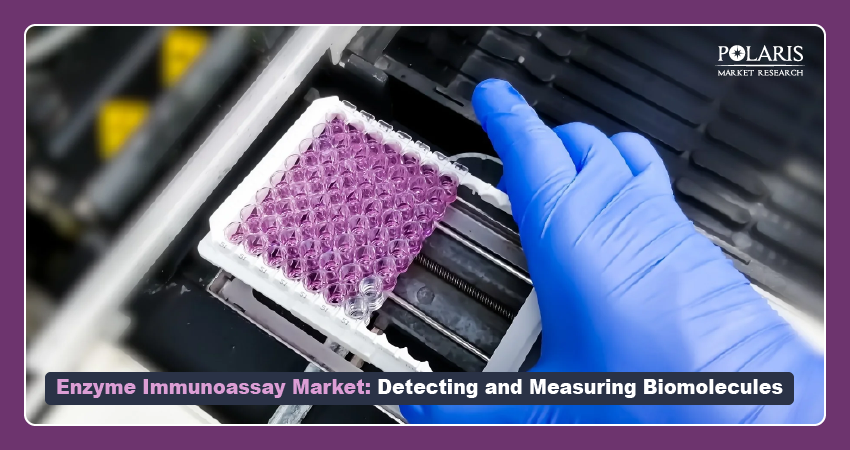Enzyme Immunoassay Market: Detecting and Measuring Biomolecules

The fields of medical diagnostics and biological research are continually evolving. Enzyme immunoassay is one of the few techniques that have had a profound impact on these fields. Merging immunology and biochemistry, the method makes it easier for scientists and clinicians to detect biomolecules with high precision.
Want to know more about enzyme immunoassays and how they work? From the commonly used enzyme immunoassay methods to the key factors driving the enzyme immunoassay market demand, this blog covers it all. Let’s dive in!
Understanding Immunoassays
The immunoassay market includes biochemical tests that rely on the specific binding of an antibody to an antigen for detecting and measuring substances in a biological sample. Understanding the working of immunoassays requires knowing how antigens and antibodies function in the body. Antibodies are substances made by the immune system. They bind to unwanted substances for their elimination from the body.
Antigens are makers that can be recognized by antibodies. They typically take the form of sugar or proteins present on the surfaces of viruses or cells. Antigens are present in various cell types. These include viruses, allergens, bacteria, proteins, tumor cells, and normal body cells. For immunoassays, lab scientists make use of antibodies or antigens present in the facility to check the presence of specific antibodies or antigens in the bodily fluid sample.
Enzyme Immunoassay: Overview
Enzyme immunoassay (EIA) also goes by the name enzyme-linked immunosorbent assay (ELISA). It is a common lab test used for detecting and counting specific antigens, antibodies, proteins, and hormones in fluid samples. ELISA is widely regarded as the gold standard for immunoassays. Tests that make use of ELISA help in diagnosing various conditions, including bacterial and viral infections. Home pregnancy tests also rely on the ELISA method. These tests detect the presence of a hormone known as the human chorionic gonadotropin (HCG).
Key Market Metrics
Our analysis reveals the enzyme immunoassay market to witness sustained growth in the years to come. The market for EIA stood at USD 17.68 billion in 2024. It is projected to account for a CAGR of 3.64% between 2025 and 2034.
Rising investment in R&D globally has led to the development of innovative enzyme immunoassay technologies that have improved performance and offer higher accuracy. Growing prevalence of cancer worldwide has also created an increased demand for immunoassay tests, impacting the enzyme immunoassay market favorably.
Types of Enzyme Immunoassays
There are four main types of enzyme immunoassays. Below is an explanation of these types:
Direct ELISA
This method involves the direct attachment of the antigen or sample to the microwell plate. After this, the binding of the detection antibody with an enzyme to the target protein takes place. The antibody here is a conjugated antibody and may be part of the research antibodies market. The addition of a substrate creates a signal. The stronger the signal, the more analyte is present. Direct ELISA is known to be simple and quick. However, it can produce high background noise and be less specific as a single antibody is used. The method is used to study inhibitory or blocking interactions. It is also useful for checking the specificity and affinity of antibodies.
Indirect ELISA
There’s an extra step in this method to detect the signal. First, the binding of a primary antibody to the specific antigen takes place. After this, a secondary antibody binds to the primary antibody. A signal is then produced by the substrate. The signal increases with the amount of antigen on the plate. The detection is easier with indirect ELISA as the secondary antibody amplifies the signal. However, the presence of a secondary antibody can sometimes result in cross-reaction. Indirect ELISA is useful for measuring the amount of naturally occurring antibodies.
Sandwich ELISA
Sandwich ELISA is a commonly used ELISA type. It makes use of two specific antibodies, which are known as matched pairs. These antibodies “sandwich” the antigen between them. The signal produced is directly proportional to the amount of analyte in the sample. The binding of two antibodies to the target protein means the method gives the highest sensitivity and specificity. The method can also be used with complex samples. However, the development is difficult and the time needed is longer. The procedure is widely used to measure the concentration of analytes in biological samples.
Competitive ELISA
Competitive ELISA is used for smaller molecules where using two antibodies isn’t possible. The working of this method is largely the same as that of the sandwich ELISA. However, there’s a conjugated antigen here that competes with the sample antigen for the same binding sites. The higher the number of antigens present, the fewer binding sites there are for the conjugated antigen. As a result, the signal is inversely proportional to the amount of protein in the sample. The method is used to detect hormones and other small molecules.
ELISA Result Types
The results of ELISA vary based on what’s being tested and the lab processing the test. The results of many ELISA tests are positive or negative, but some may be invalid.
Positive Result: A positive result indicates that the test has detected the substance it was checking for.
Negative Result: A negative result indicates that the substance being checked for hasn’t been detected.
Invalid Result: An invalid result means that there has been an error in the testing. This indicates that there has been an issue with the test or sample collection. Another test is needed here.
Conclusion
Enzyme immunoassay is a lab technique used for the detection of specific antigens, antibodies, or other substances in the blood. Various medical tests involve the use of the ELISA method. It helps measure antibodies against bacterial and viral infections. The test is also used for the detection and estimation of hormones. There are several variations of the technique available based on whether it’s detecting antigens or antibodies. The enzyme immunoassay market is witnessing product innovations and strategic partnerships among participants to increase their reach.

